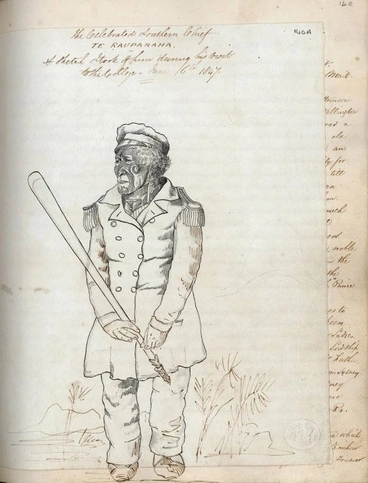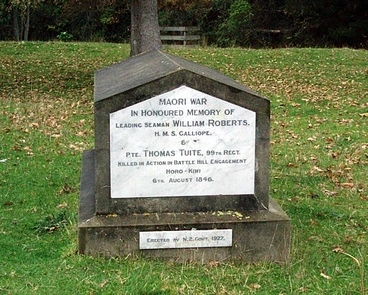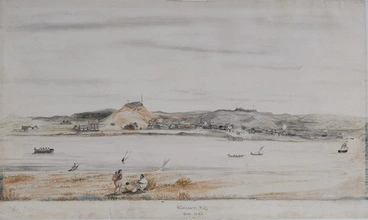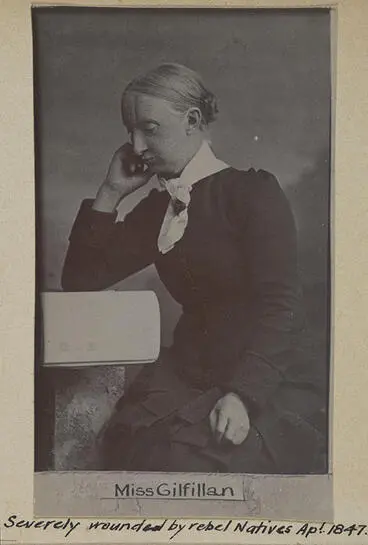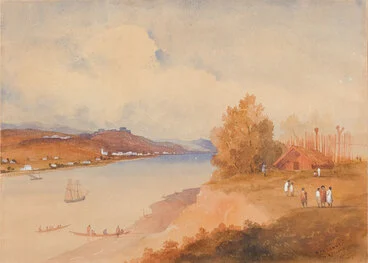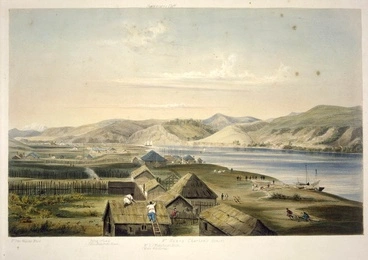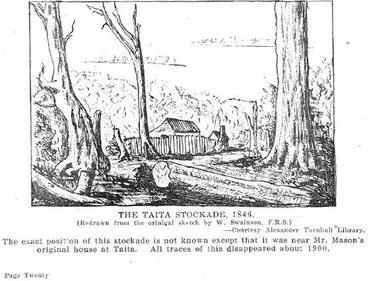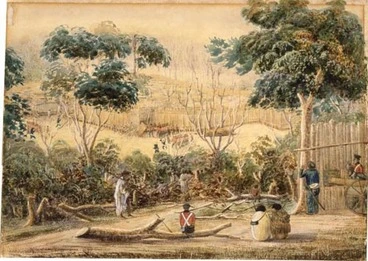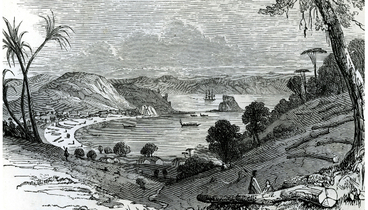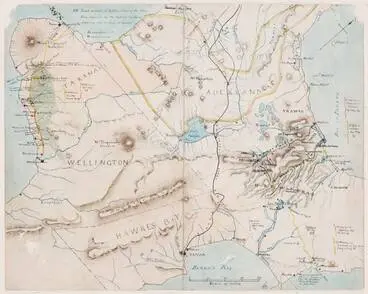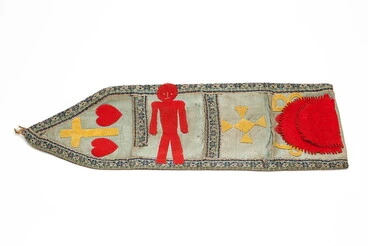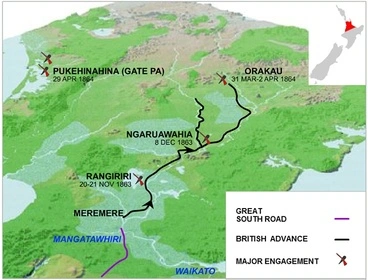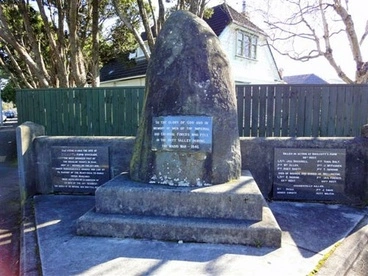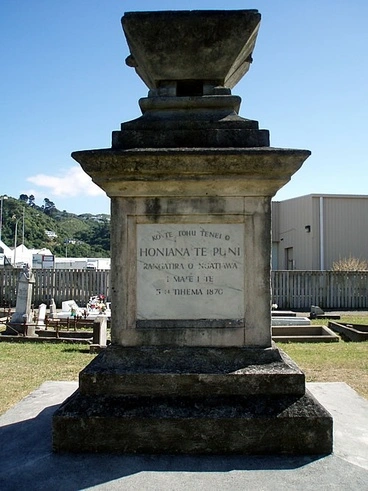War in Wellington and Whanganui 1845-47
A DigitalNZ Story by National Library of New Zealand Topics
The New Zealand Wars | Ngā Pakanga o Aotearoa campaigns in Te Whanganui-a-Tara (Wellington) and Whanganui were sparked by a growing demand for access to arable land by settlers who, from 1839, had arrived in these areas in increasing numbers. SCIS no. 1966001
social_sciences, arts, english, history, health, Māori, technology
Painting of Boulcott's stockade in Hutt Valley
Manatū Taonga, the Ministry for Culture and Heritage
War in Wellington - War in Wellington
Manatū Taonga, the Ministry for Culture and Heritage
The fight at Battle Hill
Manatū Taonga, the Ministry for Culture and Heritage
From an oil-painting by G. Lindauer, in the Municipal Art Gallery, Auckland] — Topine te Mamaku
Victoria University of Wellington
Topine Te Mamaku
Alexander Turnbull Library
WANGANUI. (Wellington Independent, 31 July 1847)
National Library of New Zealand
WANGANUI. (Wellington Independent, 04 August 1847)
National Library of New Zealand
Te Rauparaha
Manatū Taonga, the Ministry for Culture and Heritage
Te Rauparaha
Manatū Taonga, the Ministry for Culture and Heritage
Te Rauparaha
Te Rauparaha‘s arrest was a controversial move by Governor George Grey. After the attack on Boucoult’s farm, Grey saw Te Rauparaha as a cause of rising tensions over occupation and ownership of whenua in the Hutt Valley. Even though it was Te Mamaku and his Upper Whanganui river taua that led the Hutt attack Grey decided he couldn’t be trusted and had Te Rauparaha arrested by troops at dawn on May 16th 1846. Te Rauparaha’s son wrote that on seeing his captured father, he told him, ‘Son, go to your tribes and tell them to remain in peace. Do not pay for my arrest with evil, only with that which is good. You must love the Europeans. There was no just cause for my having been arrested..."
Manatū Taonga, the Ministry for Culture and Heritage
Battle Hill NZ Wars memorial
Manatū Taonga, the Ministry for Culture and Heritage
Wanganui. New Zealand. October 1847
University of Otago
Wanganui N. Zealand.
University of Otago
War in Whanganui - War in Whanganui
Manatū Taonga, the Ministry for Culture and Heritage
Whanganui in 1841
Manatū Taonga, the Ministry for Culture and Heritage
Photographer unknown: Memorial to New Zealand Wars in the Hutt Valley
Alexander Turnbull Library
Bugler’s gallantry
This headline refers to the story of a young soldier, William Allen, who blew his bugle to warn his comrades but was cut down during an attack on Boulcott’s farm in 1846. Over the years the story has attracted popular attention, with paintings of Allen romanticised as a colonial hero. Other works like articles and poems stressed a ‘Boy's Own Adventure’ tale of British Empire service and sacrifice. The story also appeared in the 1886 Christmas edition of the Auckland Weekly News and a chapter of James Cowan’s book Hero stories of New Zealand. Recently the story has resurfaced in novels, and an opera. Contemporary academic papers have also analysed the story from a post-colonial perspective.
Alexander Turnbull Library
The Taita Stockade, 1846.
Hutt City Libraries
[Swainson, William] 1789-1855 :[Stockade in clearing, Taita] 17 Oct. 184[6 or 1847?]
Alexander Turnbull Library
The Taita Post, Volume 53, 1921, Transactions and Proceedings of the New Zealand Institute, 1921
Alexander Turnbull Library
Barraud, Charles Decimus, 1822-1897 :[Te Puni seated in a whare in Pito-one Pa] N. Z. 1860
Alexander Turnbull Library
Te Wharepōuri
Manatū Taonga, the Ministry for Culture and Heritage
58th and 99th Regiments advancing up Battle Hill
It was short-lived but also a cold and wet winter campaign that saw British forces track Te Rangihaeata and his taua up the Horokiwi valley north of Wellington in August 1846. Eventually they came to Te Rangihaeata’s hastily prepared position on a ridgeline (now part of Battle Hill Farm Forest Park.) A frontal attack was considered too dangerous after 3 soldiers died when they came too close to Māori defences. The thousands of musket rounds fired by the troops had little effect as did the shells from mortars the British army dragged up the hill. On 13 August friendly Ngāti Awa fighters discovered Te Rangihaeata and his supporters had escaped during the night.
Alexander Turnbull Library
Rutland Stockade, Whanganui
Alexander Turnbull Library
Rutland stockade and jail, Wanganui
Alexander Turnbull Library
Grave of Hohepa Te Umuroa
Alexander Turnbull Library
Honiana Te Puni
Honiana Te Puni’s (Te Ati Awa) gravestone pictured here in 1940 records the enormous gratitude and reverence Pakeha had for his support during the early settlement of Wellington and the subsequent conflict in the mid-1840s. He even received a sword of honour from Queen Victoria. That support was also recognised by Pakeha at Te Puni’s funeral in 1870 which, “amounted to a state funeral.” The monument reads in-part (in Māori and English) “…erected by the New Zealand Government in consideration of the unbroken friendship between him (Honiana Te Puni ) and the pakeha."
Alexander Turnbull Library
Ngāti Toarangatira
Services to Schools
Battle Hill Farm Reserve
Services to Schools
History of Te Ātiawa
Services to Schools
Governor George Grey
Services to Schools
Te Puni-kokopu
Services to Schools
Wellington battles, 1846
Services to Schools
The fight at Battle Hill
Services to Schools
Wellington and Whanganui wars, 1846–1848
Services to Schools
Wellington/Hutt Valley 1846
Services to Schools
Wellington settlement and war in the Hutt
Services to Schools
The dispatch carrier
Services to Schools
The New Zealand Hutt Valley Campaign 1846
Services to Schools
Whanganui 1847
Services to Schools
Early Wellington
Services to Schools
Hero stories of New Zealand
Services to Schools
Boulcott’s farm
Services to Schools
Young Allen, the brave bugler boy
Services to Schools
Fighting in Whanganui
Services to Schools
The Governor - The reverend traitor
Services to Schools
St John's Wood, Whanganui, 1847
Services to Schools
Skirmish at St John’s Wood, Whanganui
Services to Schools
The war at Wanganui
Services to Schools
The shadow of war
Services to Schools
The end of the war in Wellington
Manatū Taonga, the Ministry for Culture and Heritage
Rutland stockade, Whanganui
Manatū Taonga, the Ministry for Culture and Heritage
Artist unknown :(Pukenamu) Rutland Stockade, Wanganui, New Zealand [1847]
Alexander Turnbull Library
The Wairau Affray 1843
DigitalNZ
The Northern War 1845-46
DigitalNZ
War in Tauranga 1864
DigitalNZ
War in the Waikato 1863-65
DigitalNZ
Parihaka
DigitalNZ
Boulcott's Farm NZ Wars memorial
Manatū Taonga, the Ministry for Culture and Heritage
Honiana Te Puni NZ Wars memorial
Manatū Taonga, the Ministry for Culture and Heritage
Eight killed in attack on Boulcott Farm
Manatū Taonga, the Ministry for Culture and Heritage
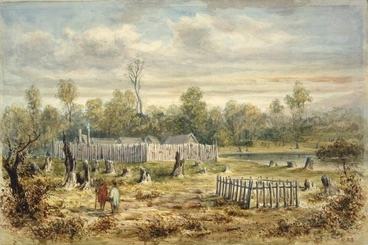
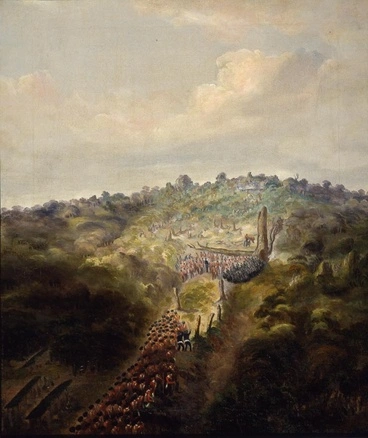
![From an oil-painting by G. Lindauer, in the Municipal Art Gallery, Auckland] — Topine te Mamaku Image: From an oil-painting by G. Lindauer, in the Municipal Art Gallery, Auckland] — Topine te Mamaku](https://thumbnailer.digitalnz.org/?resize=770x&src=https%3A%2F%2Fndhadeliver.natlib.govt.nz%2Fwebarchive%2F20201108000000mp_%2Fhttp%3A%2F%2Fnzetc.victoria.ac.nz%2Fetexts%2FCow01NewZ%2FCow01NewZ139a.jpg&resize=368%253E)


